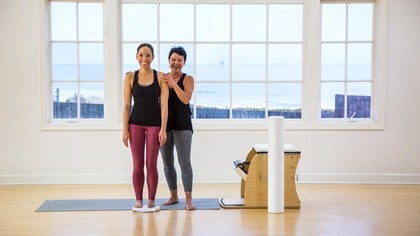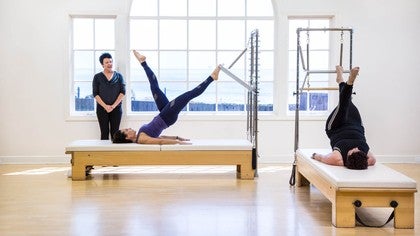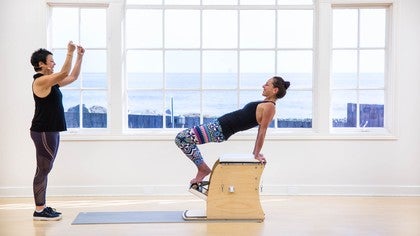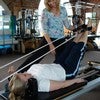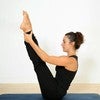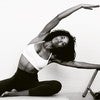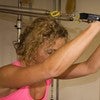Description
About This Video
Transcript
Read Full Transcript
Hi everybody. Uh, so we're back and we're, um, we're in the tutorial about leg alignment deviations. I'm here with Jia and this third section we're talking about, um, hyper extension and, um, so Jia actually presents with lovely hyperextension. So we can, I'm going to show you a sort of my current favorite way of, um, sort of motor control, um, you know, guiding my client towards ways of helping, uh, he or she control their hyperextension. Um, but I just want to like make a couple statements about hyperextension just, just sort of, we're all sort of thinking the same way. So hyperextension is his structural, um, deviation in the lake, right? So it's, it's a way in which the joint actually goes beyond sort of what, what would be a normal terminal extension moment, right? And there's a lot of variations in hyperextension. So if you look at Gea, she actually will go sideways to the camera, can see you. Um, yeah, let's get the worst one out. Yeah, there we go. Right?
So she's already told us one is more hyperextended than the other. So that's also really true, right? So this is, you really see how the the knee comes. Bose quite far back. The pelvis is quite far ahead of, um, the, the knee. And, and really importantly, I want you to notice how her ankle is really implant our fluxion when she's standing, right? So this is, uh, this is, uh, I would call this a real hyper extended knee, right? If she were to sit down, go ahead and just base me and sit down with straight legs for a second and she were to straighten her leg, right? You see how much her heel comes up there? Great. So she's got a hyper extended knee right? Now you might have somebody who you just see a little bit right of this, right?
You might have, I have students across the world who have much, much greater hyperextension than this, right? So again, you're going to see a lot of variation. But the thing that I want to say about it is that, number one, it's not dangerous. It looks kind of scary, but it doesn't hurt you, does it? Yeah. And it looks really beautiful when you're dancing, actually. Right? It like makes a beautiful line. Um, so, but we were, so I'm not really interested in talking about correcting hyperextension in like an open chain activity. So much as I'm going to say, go ahead and come back up to San Angia that we, that there are times in which when if you're always standing and doing your load base work locked back in that hyperextension that there could be potential wear and tear over time. So we're going to only talk about controlling hyperextension in a closed chain or in a floated position because frankly it's impossible to tell like in something like legs springs or even something like footwork on the reformer.
If your knee is like straight or band, right? Do you have that experience? Like, you know, so then the que tends to be like, well, micro bend your knee, right? So then you're, then you're like, have you been the, all the tie, right? So that doesn't really help either. So, so this, this is my current strategy. Again, this is coming out of, um, one of the courses that Jeremy and I teach for a movement. Science made simple. Um, so I'm going to take you through sort of the way I coach people in standing to sort of motor control, that hyper extension without using micro bending the knee as a, as it my main objective.
And then we're going to talk about different ways to, um, kind of mobilize the ankle, uh, strengthen the extensor group of the knee, um, as well as really get the hamstrings a little bit more active. We do, we do all believe that that sort of balanced work between hamstrings and quads can be really helpful, helpful in controlling hyperextension. Um, but mostly it's your brain that controls hypertension, right? So again, we're not going to change somebody. We're not going to remedy somebody's hyperextension through these like cool exercise protocols. We're going to teach them how to manage their hypertension. Right? We're not gonna tell them their hypertension is bad. We're not going to attack their hyperextension. Right. I felt like as a dancer, I was completely attacked by my hip extension all the time. They were like, don't do that. That was like, OK, you know. Um, okay, so let's go with how I'm addressing this currently. So do you have any, have you faced this way? Right? Is this the, this is the more hyperextended like, yeah. Perfect. So basically if you, if you look here from the side, which you've, you've gotten nice angle here, right? This is the viewer, her pelvis is forward and her knee is back and her ankle is actually implant our fluxion which means more of her weight is in her heel than the ball of her foot. Right? And so the very, now there's other people present with way all sorts of different variations of hyperextension.
They do all sorts of different things with their pelvises in their upper body. So the first thing we're going to do is always like an alignment practice. So I do the containers practice if you have worked with me before or any of my students. Um, but we're going to do something where we're, Jia is thinking about the aligning principles of the placement of her head on top of the bony mass of her rib cage, which we want s relatively placed on top of the bony mass of her pelvis. So she's making these corrections. I can feel them under my fingers. So that's good. And on top of the bony masses of her legs, which he could think as one or two units, however, however she wants to do that.
So depending on, cause some of your hyper extended people are going to be like super shoved backwards in their upper body and some are going to be really lordotic. So these, these, this first aligning principles primary, you've got to kind of coach that person to look for something. Right? So she's done that. She's already, she's already made a pretty severe correction or hypertension. I'm going to ask her to keep pushing that back though. So we see the full thing, right? So then here's where I go from here. So they get their alignment and then the first thing I'm going to try to ask Jia to, to work with is coming into more Dorsey flection.
So without, so she's going to bend your knees a little bit, right? Until her lower leg is in more her ankles and more Dorsey flection and her lower legs, not so far behind. So I would say just about there. So she's got better alignment through that lower leg to the, to the lateral ankle bone here. Right? And so she's going to try and keep this lower leg in a space hold, right? Meaning not, it's not going to try and she's going to try not to change it too much.
Then the next thing she needs to do is create a barrier for this femur not to be able to like come barreling back towards me. Right? So I'm going to ask her to use her hip extensors at her hamstring level and I'm going to ask her to, just to bear forward a little bit, but not shift her weight forward with her hip extensors. So she's basically creating her knees still slightly bent here. So go ahead and let those knees bend. Now do this right now. Once she has this barrier here, I'm going to ask her to engage her quads to straighten her knee, but not to send her lower leg back and space.
Go ahead and straighten the knee all the way. Right. Great. Don't go forward. Perfect. Right? So she's trying to maintain eye. I'm hoping that's looking pretty good. I'm going to try to get an alk from my friends over here, this owl, that hypertension looking better. Great. Okay, great. So she's created a more of a perpendicular line between her foot and her shinbone. Right.
And then I had her micro bender knee and then I created a barrier. I'm calling this a barrier cause it's, it's feeling like you're pushing your hamstrings into the front of your quad. And then when she contracts her quad, it makes it so she can't like push her quad with her femur way back towards me. So she's kind of making like, I call it a little sandwich of quadricep hamstring tension. Then she gets that knee extensor group to work. Right.
So go ahead and rest, love, come and sit down with me. So, um, so that's going to be my, my sort of like, hey, let's, let's see if you can find this. And then I'm going to ask them when they're doing protocols like up and down, standing on the chair or splits or different things where this really comes up and it's kind of like, whoa. Um, to try to figure out how to manage that. Right. So I'm actually sort of interesting. Jia, one of the things that inspired me to do this or smart Jeremy and I is a video we solve misty Copeland who is a great um, uh, American Ballerina who does this great little youtube video. I think it's on youtube or somewhere, um, on hyperextension and her whole own hyper extension. And I was like, it was really clever. So I was like, oh, this is really great. So you guys might want to check that out too. You should definitely see that.
Um, okay, so, uh, let's move on to, um, the fact that one of the things that we saw with Jia is that she was, she was implanted reflection, right? So that's sort of go, I go, Huh, let's try to increase that Dorsey flection of her ankle. So she has it that a little bit more available to her. Maybe that ankle is tight. Right? So Jia, you're going to come up, back up to standing and we're going to put the balls of your feet on, on this. I mean, I just kind of made this up in the studio one day just to kind of help, uh, kind of move into that Dorsey flection glide in a little bit more. So I'm just basically gonna have her do a couple of plea A's.
So she's going to bend her knees. She's going to come down lower than that. Yeah. That's all she's got. Good. And she's going to bend and he's just pretend you're going to sit down on my leg a little bit. Yeah. Let your self squat down a little. Perfect. Like that. And then straighten your legs. Right. And she's just going to keep doing that. Right. And she's trying really hard. Right. So we were on the spoon.
You're spot on here, right? We're trying to get her to really, yeah, she's pretty convinced she doesn't have more. I'm not as convinced as she is, so I'm going to help her glide that a little bit. Yeah. Great. And Hug. Good. That's better in straighten. Right? So I like, I liked this protocol. I was like one option, right? I'm not saying you have to do this, but, um, big toe mounds heavy, good and up, right? So we're going to think of ways to increase people's doors.
See fluxion you guys are pros, you have plenty of other options. Just something easy they can do at home. So then we're going to step off of this. One of the other little gems. Let's sit back down that, um, that I love to teach and I feel like also really helps with some of that grinding you hear in the knee, put your lower right leg over this. Yeah. And yeah, step this leg over, but on the floor and then bend this knee. You could use a little ball, you could use, you could do this a million different ways, but basically what we're addressing here is, um, our extensor, our knee extensors, right?
So our quads that extend our knee, the ones down here, right? So I'm going to have gs straighten her knee. She's using her knee extensors and she's going to be primarily thinking about lifting the lever of the lower leg and trying really hard not to bear down on her Femur, right? So then she's going to bend that again. She's not gonna change the position of her femur. It's in a space hold and she's going to swing just like my forearms doing right.
She's going to swing that low leg up and then that low leg is going to angle down, right? So she's not doing her regular tactic, which would be to push back to straighten her knee. She's actually, and we'll do this in tandem, like a little dance concert here. She's actually swinging that little like so she's going to get a lot more bang for her buck out of her knee extensors. Can you feel that working there and the rollers giving her feedback, right. It'll tell her if she's pushing down there. Yeah, you could always put like a little whoopee cushion under there too and the light go if you push down too much. Anyway, so again, you could think about this when you're teaching tree or a v you guys are the pros. You know, there's a variety of ways you could do that.
But I just wanted to point out, um, this has been really useful for my clients and working particularly the dancers and skaters on that. Okay. So lastly, I just want to give you a little bit of, um, thinking into hamstrings. So, uh, Jesus is going to come and lie down here and we're going to get this out of her way and she's going to push this pedal down the low chair, right? So, um, I teach this series a lot on plot. He's anytime, so you've probably seen it if you're a viewer, but again, um, we could, you know, go into some bridging here to get her hamstrings going and then I'm going to try to have her increase her Dorsey flection, right? Exactly. So she's going to start, so now she's going to roll down, right? So we could do a bunch of hamstring upper hamstring activity, like fat. She could also do some single leg, uh, pistons, right where she's having to balance out the quad in the hamstrings a little bit.
So again, I'm just trying to give you some ideas of ways that you might address the legs here. And then do that other sides that they can see that. See, she has to really stomp down here. That's Kinda tricky. And then mostly I like to do hamstring curls here. So she's gonna lift the pedal up depending on your chair. We have one middle spring, she's going to hook her heels over. I'm on this groths chair and then she's going to pull down. Yeah, actually we're going to do hamstring curls from down here. Right.
And she's going to pull, maybe your heels actually on this chair should be a little bit more angled like that you'll figure out. Right. And then up and down. So, right. So I just feel like there's not that many hamstring curls employees. So I, I, you know, you could do that at the gym on a machine, but since we're in the plotty studio, um, I just want to remind you that it's nice sometimes to just get the hamstrings to really contract those hamstrings to really contract. Um, again for hyperextension, it's, it's useful to think about balancing out or some people like to think about co contraction of the quads and the hamstrings. Um, but more than anything, again, we're talking about awareness, right? We're talking about helping people, um, GPS, their body parts navigate except their structure, live in their structure happily and know when they're kind of going a little overboard. Right? Um, so those are some of my recommendations for hyper extension. Um, I hope they help and for Valgus and various knee and, um, you can always contact me if you have questions and I hope you enjoyed yourself. Thanks to Ya.
The Teacher's Corner: Strengthening Your Lower Body
Comments
You need to be a subscriber to post a comment.
Please Log In or Create an Account to start your free trial.
